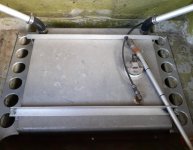how about just welding a bit of angle to the outside the frame and bolting through that?
You want to bolt the tank fairly snug and you want the weight to be carried across its whole surface, not just 6x 10mm bolt heads, which is what it will end up being once the foam compresses.
Jo
You want to bolt the tank fairly snug and you want the weight to be carried across its whole surface, not just 6x 10mm bolt heads, which is what it will end up being once the foam compresses.
Jo

